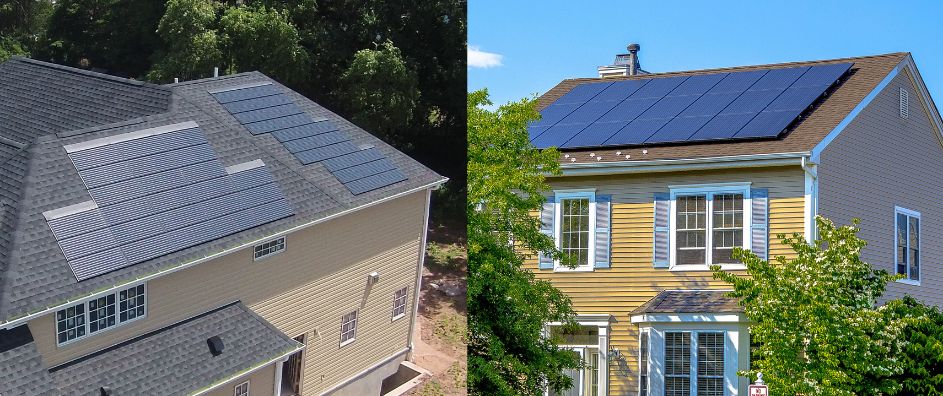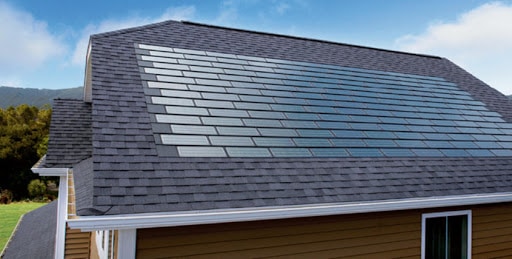The most typical way to use solar energy is to install solar panels on your roof, but solar shingles are a different option that is gaining popularity. What is therefore preferable, solar panels or solar shingles? There are distinct advantages and disadvantages to each solar option. This guide will help you comprehend what solar shingles are, how much they cost, and their benefits and drawbacks. Please continue reading to learn more.
What Are Solar Shingles? How Do They Work?
Solar shingles can be compared to tiny solar panels that blend in with the regular shingles on your roof or a new roof (if you need one). They function in the same way as conventional solar panels, but instead of being installed on top of your roof like solar panels are, solar shingles are used to construct a roof.
The most obvious advantage of this kind of solar energy system is aesthetics; unlike photovoltaic solar panels, which can be quite noticeable, solar shingles blend in with conventional roofing materials, giving your roof a completely normal appearance.
Solar shingles, like solar panels, generate clean energy through photovoltaics (absorbing energy from the sun), some of which can be stored in a solar battery and some of which are transformed into useful alternating current (AC).
Additionally, because solar panels are rack-mounted, your roof will need to have numerous holes drilled in it. On the other hand, solar shingles do not demand that, necessitating a less invasive installation procedure.
This enables you to use renewable energy to power devices and appliances throughout your home. Note: Those who prefer the appearance of a “tiled” roof to a shingled one may wish to consider solar tiles.
These function similarly to photovoltaic energy shingles but integrate with roofing tiles as opposed to asphalt shingles.
Advantages Of Solar Shingles
Solar shingles provide many benefits to customers looking for ways to reduce their energy costs, from increased home value to their appealing aesthetics.
Improved Home Value
The value of a home is raised by solar energy systems. You can think of a new solar installation as a home renovation because you’ll be spending money on a feature of your house that will hopefully increase its marketability.
When your house is on the market, solar energy can be a significant selling point. Solar energy systems increased homes’ sale values by 4.1%, according to a Zillow study. When conducting a cost-benefit analysis for their system, homeowners can include this benefit in the overall cost.
Environmental Impact
Using solar energy is a great way to protect the environment, whether you opt for solar tiles or solar panels. For powering buildings and homes, solar systems rely on renewable energy.
As more homes are bought and sold with a pre-installed solar roof, choosing solar shingles can help keep the trend going.
Polished Appearance
One advantage of solar shingles over conventional shingles is that they are solar panels is a modern appearance. Tesla solar shingles seamlessly integrate into the roof’s aesthetic. The design of these solar shingles mimics the appearance of asphalt shingles while being unobtrusive.
Those who prefer solar energy without the appearance of solar panels may find this sleek appearance appealing. Currently, solar shingles are available in the same blue and black hues as solar panels. In contrast to conventional solar panels, Tesla intends to provide more color choices for solar roof tiles.
Modern Convenience
The software that lets you monitor your energy production is included with many solar shingles. For instance, the Tesla app gives you 24/7 access to monitor and manage your roof’s operation. It’s a small but creative perk that gives you convenience and energy usage control.
Disadvantages Of Solar Shingles
Although installing solar shingles has advantages, you should be aware of some disadvantages as well.
Slow Installation
Solar shingles do not have as many installers as solar roof tiles because of their recent development. As a result, there might be a longer wait time if you decide to install a solar roof.
Expensive
Many people are curious as to which is more expensive: solar panels or solar shingles., Much more expensive than solar panels are solar shingles.
When you need to replace your roof, solar shingles are frequently the best option. When deciding whether installing a solar roof is financially feasible, you should take into account the home’s value and the savings on energy.
Lower Productivity
Solar shingles are incorporated into the particular roof angle, as opposed to solar panels, which can be strategically positioned to receive the most sunlight. The solar tiles will perform less effectively if a portion of the roof receives little sunlight.
The best amount of sunlight can be captured using individual solar panels, which can be positioned and turned. Additionally, they don’t obstruct the roofing material below.

Limited Mobility
If you decide to move homes, a solar roof is much more challenging to transfer than solar panels. When selling, you should prepare to leave your solar tiles with their respective homes and increase the market value of the entire house.
Higher Failure Rates
In a system of the same size, there are many more solar shingles than panels, so all of them must be electrically connected. With each additional shingle, there are more potential points of failure. This is reflected in the fact that solar shingles fail more frequently in actual use than solar panels.
How Do Solar Panels Work?
The sun is the origin of all solar energy. To manipulate the sun’s rays and transform them into energy, solar panels employ technology similar to that used in solar shingles. They are made to turn sunlight into electricity.
All visible light is composed of particles called photons, which are present in the sun’s rays as they enter our atmosphere. With the aid of the photovoltaic effect, solar panels harness the continuous stream of photons striking the planet to produce electricity.
Numerous material-filled cells create positive and negative charges inside solar panels. An electron from one of these materials is knocked out of its atom when a photon strikes the solar panel, which initiates an electric circuit and turns the energy into electricity.
Direct current, which solar panels produce, is unsuitable for use in a home. You will also need to set up an inverter to convert the direct current produced by solar panels on your roof into usable alternating current.
Commercial and residential uses of solar panels range from supplying a remote cabin with electricity to illuminating office buildings. Interestingly, Google is one of the top businesses that powers its offices with renewable energy sources like solar panels.
Even outside of just supplying electricity to homes and businesses, solar energy is useful for a variety of tasks. They are additionally employed to heat industrial procedures.
By 2050, the US Department of Energy wants to see a carbon-free energy industry. It can accomplish this by utilizing solar energy in the manufacturing of chemicals, food, and desalinated water.
Solar panels are an efficient way to generate electricity for your home or place of business, but they can also be used to heat, ventilate, and do other things with solar energy. They are also being used to reduce carbon footprints on a large scale.
Pros And Cons Of Solar Panels
Pros:
- Proven technology with half a century of experience
- Can increase the resale value of your home
- Can last more than 40 years
Cons:
- Not functional for every home
- Don’t “work” after the sun goes down
- Not as aesthetically pleasing
Your decision will be influenced by which option best fits your lifestyle, financial situation, and geographic location. Some people place the greatest value on appearance, price, and efficiency, but others might not care as long as it’s the greenest choice.
Similarities Between Solar Shingles And Solar Panels
- Photovoltaic technology: All solar inverters and solar shingles are connected to the electrical grid and paired with solar panels.
- Incentives: The same tax breaks available to traditional solar panel systems, like the 26% federal solar tax credit, are typically available to solar shingle installations.
- Net metering policies: The same regulations apply to all building-integrated photovoltaic systems, allowing you to send any excess electricity they produce to your utility for a credit on your electric bill.

Differences Between Solar Shingles And Solar Panels
- Cost: The cost of solar panels is typically much lower than that of solar shingles. That’s because installing solar shingles is typically more expensive and there are fewer brands available.
- Efficiency: Solar shingles use the same technology as solar panels, but they are less effective because there is less airflow under them, which means they can’t cool as easily as panels with conventional racking equipment. The size of your roof may be able to counteract this issue because bigger roofs can capture more sunlight, which reduces the impact of efficiency.
- Flexibility: Standard asphalt shingles are intended to be replaced or covered with solar shingles. Contrarily, solar panels can be attached to any roof material, from rubber to metal.
- Lifetime: Solar shingles and panels are made to last for at least 20 years. Any solar panels, however, must be removed and paid for to be reinstalled if your roof needs to be repaired. Solar shingles should still be covered by warranty for about 20 years, but you might need to replace any that are damaged.
- Placement: Solar shingles are typically installed in locations with year-round high levels of sunlight. For solar panels, the same is true, but they can tilt to follow the sun, unlike solar shingles, which are fixed in place.
How Much Do Solar Shingles Cost?
Generally speaking, solar shingles will cost more than solar panels. Having said that, the price of a solar shingle roof can vary depending on the company you choose.
According to Solar Magazine, the average cost of installing solar shingles is between $15,000 and $20,000 (or roughly $21 to $25 per square foot). There are aberrations, of course. For complete roof installation, high-end solar shingles from a company like Tesla could cost up to $70,000 or more.
To ensure you get the best deal, it’s best to shop around and compare prices from at least two or three different solar shingle companies before installing. Also keep in mind that solar tax credits, rebates, and other incentives are available to homeowners who choose solar shingles in addition to those who choose solar panels.
The current federal incentive program, which is valid for all installations made through 2032, will reimburse you for 30% of the cost of your system as a tax credit.
Do You Have The Right Solar Shingles?
It depends, is the short answer to this query. There are many things to take into account when deciding between solar panels and solar shingles for a solar system installation.
A solar system purchase decision is truly unique to each property and homeowner or business owner considering the switch, taking into account factors such as availability in your area and the current state of your roof.
To answer this question, you’ll primarily want to consider these two factors:
- Solar shingles are more expensive, but they also look nicer than solar panels.
- Solar tiles don’t produce as much electricity as solar panels do, but they can still produce enough to pay for 40 to 70% of your electricity expenses.
Bottom Line
Because it depends on your particular circumstances, preferences, and geographic location, it is impossible to say which kind of green energy source is best.
Solar shingles might not be the best investment if your roof is in good condition and still has more than five years of life left in it. But installing a solar roof using solar shingles might be a good choice if you need a new roof and your house gets a lot of sunlight.
